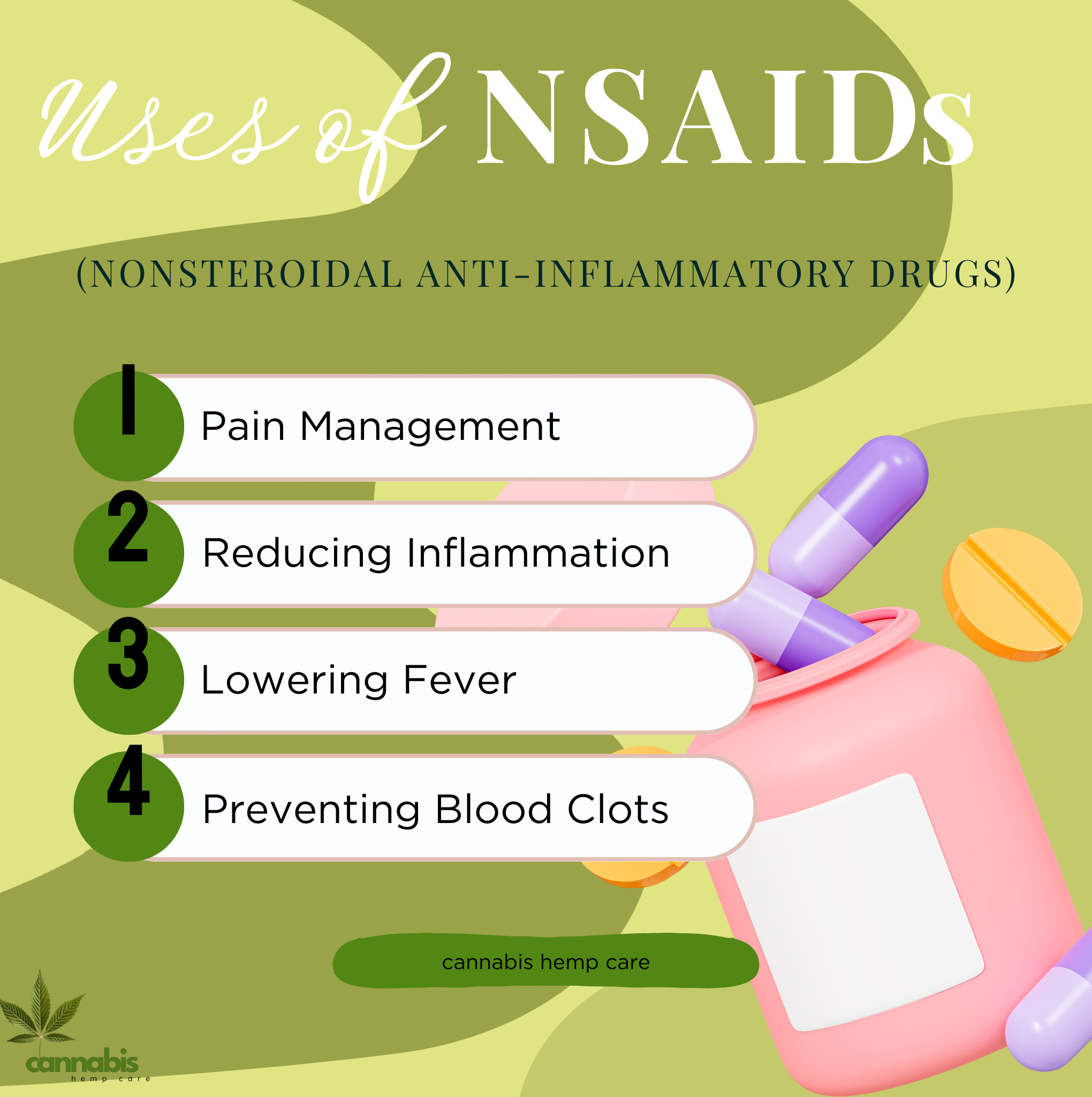Nonsteroidal anti-inflammatory drugs, or NSAIDs for short, are a type of medication that can help to relieve pain, lessen inflammation, and reduce fever.1 These medications come in a variety of forms, including tablets, capsules, liquids, gels, creams, and even suppositories.
What Are NSAIDs?
NSAIDs are a type of medication that inhibits a particular set of enzymes known as cyclo-oxygenase, or COX enzymes. These enzymes play an important role in creating prostaglandins, which are compounds that behave like hormones and regulate various bodily processes, including inflammation, blood circulation, and clot formation.
Uses Of NSAIDs
Nonsteroidal Anti-Inflammatory Drugs, or NSAIDs, serve a variety of functions. They are typically used to ease pain, lessen inflammation, and reduce fever. Here are some specific applications:
- Pain management: NSAIDs are useful in managing mild to moderate pain resulting from headaches, menstrual cramps, toothaches, sprains, and strains.
- Reducing inflammation: They are employed to decrease inflammation caused by conditions like rheumatoid arthritis, osteoarthritis, and gout.
- Lowering fever: NSAIDs are effective in reducing fever.
- Preventing blood clots: Aspirin, a type of NSAID, is frequently used in low doses to prevent blood clots that could lead to heart attacks and strokes.

Types Of NSAIDs
Nonsteroidal Anti-Inflammatory Drugs, or NSAIDs, are available in various forms, each differing in their chemical structure and selectivity. Here are some examples:
- Acetylated salicylates: A well-known representative is Aspirin.
- Non-acetylated salicylates: This category includes Diflunisal and Salsalate.
- Anthranilic acids: Meclofenamate and Mefenamic acid fall under this group.
- Propionic acids: Common examples are Naproxen and Ibuprofen.2
- Enolic acids: This group includes Meloxicam and Piroxicam.
- Acetic acids: Diclofenac and Indomethacin are part of this category.
- Naphthylalanine: Nabumetone is an example of this type.
- Selective COX-2 inhibitors: Celecoxib and Etoricoxib are representatives of this type.3
NSAIDs can be divided into two groups: non-selective and selective. Non-selective NSAIDs act on both COX-1 and COX-2 enzymes, while selective NSAIDs, also referred to as COX-2 selective, target only COX-2.
Risks And Benefits Of NSAIDs
NSAIDs are highly effective in reducing inflammation, relieving pain, lessening stiffness, and lowering fever. However, they can lead to the development of stomach ulcers in some individuals. To mitigate the risk of ulcers, it’s recommended to take NSAIDs with food, ideally a full meal. While NSAIDs are proficient at alleviating symptoms, they do not aid in the body’s healing process. In fact, studies indicate that these medications may hinder the body’s natural healing mechanism.
Side Effects Of NSAIDs
Like all medications, NSAIDs can have side effects. Here are some potential side effects:
- Gastrointestinal issues: The most common side effect of NSAIDs is stomach problems. This can include stomach irritation or pain, heartburn, gas, diarrhea or constipation, bleeding and ulcers, nausea, and vomiting. Taking NSAIDs with food, milk, or an antacid can help reduce these side effects. Consuming alcohol while taking NSAIDs can increase your risk of internal bleeding.4
- Cardiovascular risks: With the exception of aspirin, NSAIDs can increase your risk of high blood pressure, stroke, or heart attack. The risk may increase with longer use of NSAIDs and is also more likely at higher doses.
- Hypertension: All NSAIDs can increase your blood pressure, regardless of whether you already have high blood pressure (hypertension). NSAIDs may also reduce the effectiveness of some blood pressure medications.
- Other side effects: Other potential side effects include indigestion, headaches, dizziness, and drowsiness.

Who Can Take NSAIDs
While NSAIDs can be taken by most individuals, certain groups of people should exercise caution. It’s advisable to consult with a healthcare professional before taking an NSAID if you:
- Are aged 65 or older
- Are pregnant or attempting to conceive
- Are currently breastfeeding
- Have asthma
- Have previously had an allergic reaction to NSAIDs
- Have a history of stomach ulcers.
- Have issues with your heart, liver, kidneys, blood pressure, circulation, or digestive system.
- Are currently taking other medications
- Are seeking medication for a child under 16 (Aspirin should not be given to children under 16)

Overdoses Of NSAIDs
Consuming an excessive amount of NSAID can be harmful and may lead to an overdose. Symptoms of an overdose might include nausea, upset stomach, or drowsiness.5 In severe cases, an overdose could result in seizures, difficulty breathing, or even loss of consciousness.
Recommended Dosage Of NSAIDs
The dosage of NSAIDs can vary based on the specific medication and the condition it’s being used to treat. Here are some general guidelines for ibuprofen, a commonly used NSAID:
- For Dysmenorrhea (painful menstruation): The recommended dosage is 200 to 400 mg taken orally every 4 hours as needed. The maximum daily dose is 3200 mg for prescription strength and 1200 mg for over-the-counter strength.6
- For minor arthritis pains: The initial dose is usually 200 mg taken orally every 4 to 6 hours. This can be increased to 400 mg every 4 to 6 hours as needed. The maximum daily dose for over-the-counter strength is 1200 mg.
- For Rheumatoid Arthritis and Osteoarthritis (including flare-ups of chronic disease): The recommended dosage is 1200 to 3200 mg taken orally per day in divided doses 3 or 4 times a day.
- For fever in children over 2 years of age: The usual dose is 5 milligrams (mg) per kilogram (kg) (about 2.2 mg per pound) of body weight for fever lower than 102.5 °F (39.2 °C). For higher fever, the dose is usually 10 mg per kg (about 4.5 mg per pound) of body weight. The medicine may be given every six to eight hours, as needed, up to 40 mg per kg per day.
- For mild to moderate pain in adults and teenagers: The recommended dosage is 400 milligrams (mg) every four to six hours, as needed.

Final Words
NSAIDs, or Nonsteroidal Anti-Inflammatory Drugs, are a diverse group of medications widely utilized to relieve pain, decrease inflammation, and reduce fever. They function by inhibiting certain enzymes known as cyclo-oxygenase enzymes, which are involved in the production of substances that regulate various processes such as inflammation, blood flow, and clot formation. While NSAIDs are effective in treating a range of conditions, they can also lead to potential side effects and risks. Hence, it’s crucial to use them responsibly and under the supervision of a healthcare provider. Always seek advice from a healthcare provider before starting any new medication. Adhering to the recommended dosage is also essential to prevent the risk of an overdose. When used correctly, NSAIDs can offer significant relief from pain and inflammation.
FAQs
Sources
- Drugs.com. “Nonsteroidal Anti-Inflammatory Drugs.” Drugs.com, Drugs.com, 2018, www.drugs.com/drug-class/nonsteroidal-anti-inflammatory-agents.html. Accessed 3 Nov. 2023. ↩︎
- “NSAIDs: When to Use Them and for How Long.” Cleveland Clinic, my.clevelandclinic.org/health/treatments/11086-non-steroidal-anti-inflammatory-medicines-nsaids. Accessed 3 Nov. 2023. ↩︎
- “List of NSAIDs from Strongest to Weakest.” Www.medicalnewstoday.com, 28 Dec. 2022, www.medicalnewstoday.com/articles/list-of-nsaids-from-strongest-to-weakest. Accessed 3 Nov. 2023. ↩︎
- Hecht, Marjorie. “NSAIDs and Side Effects: Common & Urgent.” Healthline, 23 July 2019, www.healthline.com/health/side-effects-from-nsaids. Accessed 3 Nov. 2023. ↩︎
- Livehealthily.com, 2023, www.livehealthily.com/health-library/drugs/anti-inflammatories-non-steroidal. Accessed 3 Nov. 2023. ↩︎
- Drugs.com. “Ibuprofen Dosage.” Drugs.com, Drugs.com, 2018, www.drugs.com/dosage/ibuprofen.html. Accessed 3 Nov. 2023. ↩︎




































